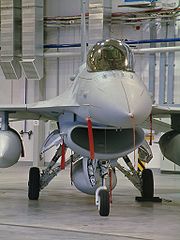
Bubble canopy
Encyclopedia

Soap bubble
A soap bubble is a thin film of soapy water enclosing air, that forms a hollow sphere with an iridescent surface. Soap bubbles usually last for only a few seconds before bursting, either on their own or on contact with another object. They are often used for children's enjoyment, but they are also...
, which attempts to provide 360° vision to the pilot.
History
Bubble canopies have been in use since World War IIWorld War II
World War II, or the Second World War , was a global conflict lasting from 1939 to 1945, involving most of the world's nations—including all of the great powers—eventually forming two opposing military alliances: the Allies and the Axis...
. The British had already developed the "Malcolm hood
Malcolm hood
The Malcolm Hood is a type of pilot canopy for aircraft. Originally developed for the Supermarine Spitfire, its concept proved valuable for other aircraft such as the North American Aviation-produced P-51B & C Mustangs and the Vought F4U Corsair...
", which was a bulged canopy, but the British Miles M.20
Miles M.20
|-See also:-References:NotesBibliography* Amos, Peter and Don Lambert Brown. Miles Aircraft Since 1925, Volume 1. London: Putnam Aeronautical, 2000. ISBN 0-85177-787-0....
was one of the first aircraft designs to feature a true bubble canopy. Although it never went into production the concept of the bubble canopy was utilised on other British aircraft, such as the Hawker Typhoon
Hawker Typhoon
The Hawker Typhoon was a British single-seat fighter-bomber, produced by Hawker Aircraft. While the Typhoon was designed to be a medium-high altitude interceptor, and a direct replacement for the Hawker Hurricane, several design problems were encountered, and the Typhoon never completely satisfied...
and Tempest
Hawker Tempest
The Hawker Tempest was a British fighter aircraft primarily used by the Royal Air Force in the Second World War. The Tempest was an improved derivative of the Hawker Typhoon, and one of the most powerful fighter aircraft used during the war....
. It was also fitted to the P-51 Mustang
P-51 Mustang
The North American Aviation P-51 Mustang was an American long-range, single-seat fighter and fighter-bomber used during World War II, the Korean War and in several other conflicts...
and P-47 Thunderbolt
P-47 Thunderbolt
Republic Aviation's P-47 Thunderbolt, also known as the "Jug", was the largest, heaviest, and most expensive fighter aircraft in history to be powered by a single reciprocating engine. It was heavily armed with eight .50-caliber machine guns, four per wing. When fully loaded, the P-47 weighed up to...
amongst others.
Purpose
The purpose of a bubble canopy is to give a pilot a much wider field-of-view than flush canopies, such as those seen on P-47s and early models of the P-51, which left a conspicuous blind spot behind the pilot that enemy pilots could take advantage of to sneak up on an aircraft.Bubble canopy increases the pilot's field of view at the expense of rear armor of the cockpit, making the pilot more susceptible to enemy gun fire from the rear. This is less of a concern in modern jet fighters as most aerial combats are settled with air to air missiles from long distances, and nearly all have some kind of radar to catch those sneaking up from behind.

